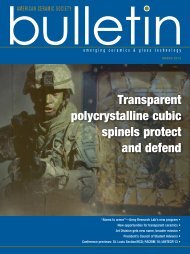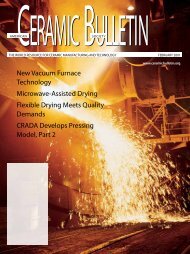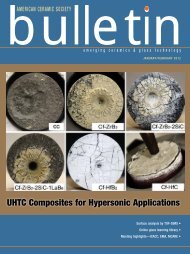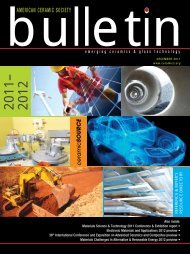American Ceramic Society Bulletin
American Ceramic Society Bulletin
American Ceramic Society Bulletin
You also want an ePaper? Increase the reach of your titles
YUMPU automatically turns print PDFs into web optimized ePapers that Google loves.
A report on the Indo-U.S. Joint Center<br />
for Biomaterials for Health Care<br />
by Bikramjit Basu and Thomas Webster<br />
D<br />
uring the past few decades, materials for<br />
biomedical applications have received<br />
much attention in the scientific community, primarily<br />
because biomaterials are capable of replacing,<br />
reconstructing and regenerating human/<br />
animal body tissues for long-term use, with little<br />
toxic or inflammatory effects.<br />
Biomaterials, as well as their applications as artificial organs, are, therefore,<br />
recognized as an emerging area for material scientists, biotechnologists, chemists,<br />
engineers and medical professionals. Traditionally, biomaterials have been<br />
created by largely trial-and-error processes. For example, titanium was initially<br />
considered for orthopedic applications because it is lightweight and strong<br />
(clearly important for artificial joint applications).<br />
This approach has sufficed to date to help restore organ function and at<br />
least partially return a quality of life to persons suffering from various diseases.<br />
However, all of the implants currently used today to treat body ailments – from<br />
orthopedics to the vasculature – have limited lifetimes, which are often less<br />
than that of the patient. Moreover, there is room to improve the functionality<br />
and the quality of life of the patient.<br />
Clearly, approaches other than trial-and-error-engineering are needed to<br />
design even better implants for the coming generations.<br />
Center created<br />
For these reasons, Indo–U.S. Science and Technology Forum established<br />
the Public–Private Networked R&D Center on Biomaterials for Health Care<br />
with these writers – Bikramjit Basu as director and Thomas Webster as codirector<br />
– in November 2008. S.P. Mehrotra, Department of Materials Science and<br />
Engineering, IIT Kanpur, is the nodal coordinator of the center.<br />
The R&D Center includes the participation of<br />
• Two academic institutes from India (IIT Kanpur and IIT Mumbai);<br />
• Three academic institutes from United States (Brown University,<br />
University of Texas, San Antonio, and University of Washington, Seattle);<br />
• Two national research labs from India (National Metallurgical Laboratory<br />
and the Non-Ferrous Technology Development Center); and<br />
• One private U.S. company (Shaping Concepts LLC located in Texas).<br />
The Center for Biomaterials for Health Care is the largest of all the Indo–<br />
U.S. research centers currently funded by IUSSTF. The Center’s projects range<br />
from mimicking the natural chemical and nanostructure of natural tissues to<br />
creating improved biomaterials to developing sensors that can determine in<br />
real time in-situ events surrounding implants (to ensure their success).<br />
In particular, the general aim of the Center for Biomaterials for Health Care<br />
has been to combine innovative material science concepts (including nanotechnology)<br />
with biological science approaches to develop implants that can<br />
last the lifetimes of the patients and to return those patients to the lifestyles<br />
38 <strong>American</strong> <strong>Ceramic</strong> <strong>Society</strong> <strong>Bulletin</strong>, Vol. 90, No. 4






